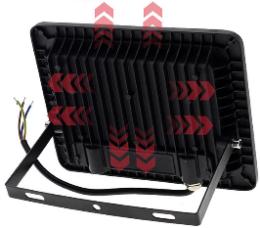In the outdoor lighting of floodlights, Home Security Lights play an important role. Some special occasions, such as the lighting of squares, intersections, certain venues, etc., because of their particularity, or the lighting Requirements, sometimes high-power lighting is often needed. In the past, many lighting projects used high-power high-pressure sodium lamps with a structure of multiple lamp heads to meet the lighting needs.
The quality of the radiator of a lamp is the primary issue that directly affects the size of the light decay. The three basic methods of heat dissipation technology and heat transfer of the lamp housing are: conduction, convection and radiation. The thermal management also starts from these three aspects, which is divided into transient analysis. And steady-state analysis. The main transmission path of the radiator is conduction and convection heat dissipation, and the radiant heat dissipation under natural convection cannot be ignored. The lighting fixtures mostly use high-power LEDs.

At present, the luminous efficiency of commercial high-power LEDs is only 15% to 30%, and most of the remaining energy is converted into heat energy. If the heat energy cannot be effectively discharged, it will lead to serious consequences. High temperature will reduce the luminous flux and luminous efficiency of the LED, cause light wave redshift, color cast, and also cause bad phenomena such as device aging. The most important thing is that the life of the LED will be exponentially reduced, due to the light decay of the LED or its life. It is directly related to its junction temperature. If the heat dissipation is not good, the junction temperature will be high and the life will be short. According to Arrhenius's law, the life will be extended by 2 times for every 10°C decrease in temperature.
Post time: Sep-28-2021






